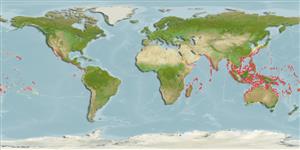Common names from other countries
Environment: milieu / climate zone / depth range / distribution range
Ecología
; rango de profundidad 62 - 64 m (Ref. 101029). Tropical
Indo-Pacific.
Length at first maturity / Tamaño / Peso / Age
Maturity: Lm ? range ? - ? cm Max length : 10.0 cm ShH macho / no sexado; (Ref. 349); common length : 8.5 cm SHL macho / no sexado; (Ref. 349)
Length based on occurrence record; to be replaced with better reference. Lives in shallow waters near coral reefs (Ref. 799). Lower intertidal fringe and sublittoral to shelf zones (Ref. 349). Feeds on small crabs (Ref. 85382).
Life cycle and mating behavior
Madurez | Reproducción | Puesta | Huevos | Fecundidad | Larva
This species is a non-broadcast spawner. Life cycle does not include trocophore stage. Also Ref. 833.
Poutiers, J.M. 1998. (Ref. 349)
IUCN Red List Status (Ref. 130435)
CITES status (Ref. 108899)
Not Evaluated
Not Evaluated
Threat to humans
Harmless
Human uses
Pesquerías: comercial
| FishSource |
Herramientas
Más información
Age/SizeCrecimientoLength-weightLength-lengthMorfologíaLarvaAbundancia
Fuentes de Internet
Estimates based on models
Preferred temperature
(Ref.
115969): 20.6 - 28.5, mean 26.9 (based on 28 cells).
Vulnerability
Low vulnerability (10 of 100).
Price category
Unknown.
